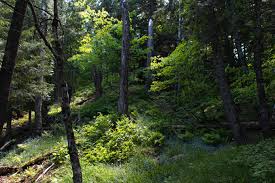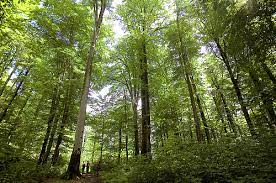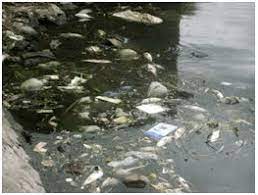Forest Resource and Importance of Forest
Forest and related land cover types (woodlands shrubland, degraded forest and forest fallows) are important terrestrial ecosystems. They account of over 52x 106 km2 of the earth’s land area, occupy three times the area of cropland and 75% of more area than grasslands.
They are vital to the ecological functioning of the planet, producing 60% of the net productivity of all terrestrial ecosystems, of which tropical forests account for approximately two-third.
They are also the habitat of a large proportion of the earth’s plant and animal species, providing the basis for the biodiversity which is essential for the biosphere’s future.
They essentially support life on earth by absorbing carbon dioxide and releasing oxygen thereby maintaining the balance in the gaseous atmosphere and also in regulation of hydrological cycle and flood control.
Forests are important for provision of a wide range of products such as timber, fuel wood, paper, food and fodder as well as ecosystem services like protection of soil and water resources and carbon sequestration.
Forest Resource
The world’s forests serve a series of vital environmental and ecosystem services (i.e. benefits people obtain from ecosystems), without which the functioning of the biosphere would be endangered.
Woodlands and forest regulate water regimes by intercepting rainfall and regulating their flow. This is particularly important in areas with highly seasonal rainfall, as in the case of many tropical regions.
Trees are vital to the maintenance of soil quality, providing organic matter through leaf fall, limiting soil erosion through the binding effects of root systems and protecting soil from the direct impact of rainfall.
On a regional and global scale forest play a part in modulating climate and are the lung of the planet.
Deforestation is believed to contribute as much as 25% of the increased carbon dioxide which is the principal cause of enhanced greenhouse effect and this occurs because heat-trapping gases are released by the burning of felled woodland and because the absorption of carbon from the atmosphere via photosynthesis is reduced.
Tree resources are of major economic importance and form the basis of a wide range of industries, notably timber, processed wood and paper including products such as rubber, fruits, nuts and coffee etc.
The world’s forests are also the home of millions of people, many of whom live preindustrial lives and have unique cultural heritages. These ways of life depend totally on the survival of the forest, and are under threat from spectre of deforestation.
Forest and woodland are also the source of many products which are vital to the viability of agricultural communities throughout the developing world, e. g. fuel, fruits, building materials, medicines and herb.
Read Also : City and Environmental Degradation
These forest products provide diversity to the rural economy and security when times are hard. The loss of tree resources undermines the viability of agricultural economies and in particular makes the poor more vulnerable to environmental disruption.
Deforestation, particularly in developing countries, is consequently not only an environmental problem, but also an ecological and developmental disaster.
Importance of Forest
In consideration of the importance of forest much of the deforestation currently taking place is undesirable for a number of reasons:
At the local scale forest and woodland canopy protects soil from rainfall, reducing erosion and regulating runoff. Forested areas produce more even water flow as the soil acts as major store in the hydrological cycle.
This buffering role is especially important in regions with irregular or strongly seasonal rainfall such as monsoon areas of Asia and semi-arid regions.
Forest creates local microclimates regulating temperature and humidity in their immediate vicinity. Generally, temperature is moderated, humidity is increased and wind speed reduced.
Forest environments create ideal microclimate for a number of crops, although solar radiation can be limited by canopy cover. Such environments also provide habitats for many flora and fauna which add to the variety and durability of local environments.
On regional and global scales forest resources plays a major role in environmental regulation and preservation.
Some local functions such as soil protection and regulation of the hydrological cycle also operate at a regional scale and deforestation is often cited as a major contributing factor to disaster such as downstream flooding of previously forested areas.
Also the effects of droughts in arid and semi-arid areas are worsened by the loss of vegetal cover.
Forest performs two major environmental functions at global scale, both of which are seriously threatened by current patterns of deforestation. Firstly, their roles as carbon sink in the global carbon cycle and secondly as pools of biodiversity, i. e. as the home of a vast number of species of plant and animals

The world biomass resources of which forests and woodlands are the largest component play a key role in global climate mitigation by providing sink for greenhouse gas that contribute to global warming.
Their contribution to climate change takes place through the process of photosynthesis whereby plants absorbs carbon dioxide and release oxygen.
The loss of a significant proportion of the world’s biomass stocks through deforestation will consequently lead to a reduced capacity to absorb carbon dioxide and could in the long term causes other forms of disruptions to the composition of the atmosphere.
Not surprisingly, the reversal of deforestation trends and a move to significant re-afforestation is seen by many as a key component in global efforts to mitigate the impact and speed of global warming.
Causes of Deforestation
Deforestation occurs as a result of outright destruction of woodland through fuel wood and timber harvesting and tree cutting for fodder and grazing. African closed forest has also been loss through steady expansion of hardwood logging.
In tropical Asia closed forest destruction has been due to land clearance for agriculture, planned migration and resettlement project. Urban development and expansion and construction activities also increased the tempo of logging activities.
Unauthorized felling of trees in excess of what can be harvested normally from the forest to earn money from selling the forest resources is also responsible for deforestation.
Read Also : Land Cover Change and Deforestation
Practices in some culture to ward off witches and wizards by cutting down trees could also contribute to deforestation. Commercial logging and establishment of heavy industries also contribute to deforestation.
In some coastal communities land conversion particularly the clearance of mangrove swamps to provide land for swamp rice cultivation.
There is no doubt that in some areas growing population densities have had an adverse impact on forest resources, but this is mainly through land clearance for agriculture and greater demand for fodder from increasing livestock populations.



